Six Ocean Creatures Ready for Halloween

By Emily Tripp
There’s quite a collection of Halloween-themed marine life, but some are much better than others. Here are six creepy creatures that are ready for Halloween:
Bat Rays
The Bat Ray, Myliobatis californica, is an eagle ray found in the muddy and sandy bottoms of bays, kelp forests and coral reefs. It lives in the eastern Pacific Ocean from Oregon to the Gulf of California and can also be found near the Galapagos Islands. Bat rays flap their ‘wings’ in the sand to expose buried prey, like clams. Typically solitary creatures, they can occasionally be seen in groups of thousands. Their primary predators are sea lions.
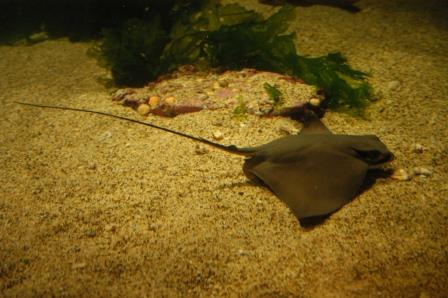
Bat ray, Myliobatus californica, at the Monterey Bay Aquarium. Photo credit: David Parker.
Ghost Crabs
The Ghost Crab, Ocypode quadrata, also known as the sand crab, is a shore crab found all along coast from Rhode Island to Brazil. It gets its name from its ability to blend into the sandy beaches in which it lives. It eats insects, clams and the eggs and hatchlings of loggerhead turtles. If you’re brave, watch this video of a hatchling battling a ghost crab, keeping in mind that only one in every thousand baby sea turtles makes it to adulthood…
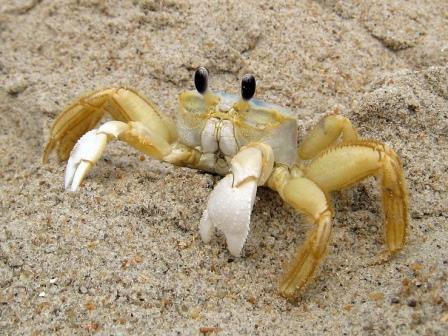
Ghost crab, Ocypode quadrata. Photo credit: Hatchibombotar via photopin cc.
Goblin Sharks
The Goblin Shark, Mitsukurina owstoni, is a rarely seen species of deep-sea shark and you have to see how it eats. This creepy shark has an elongated, flat snout and its mouth can protrude far out into the water. Specimens have been seen in the Atlantic, the western Pacific and the Indian Oceans. Most have been observed near continental slopes between 885ft (270m) and 3,149 (137m) feet deep. However, the goblin shark has only been described in scientific literature a few dozen times.

Goblin shark, Mitsukurina owstoni, at the Natural History Museum in Vienna. Photo credit: Peter Halasz.
Halloween Crabs
The Halloween Crab, Gecarcinus quadratus, lives in mangroves, sand dunes and rainforests along the Pacific coast from Mexico to Peru. It’s called the Halloween crab because of its color — it has a black carapace, orange legs, and purple claws. This nocturnal crab lives among the trees for at least part of its adult life, but must return to the ocean to breed.
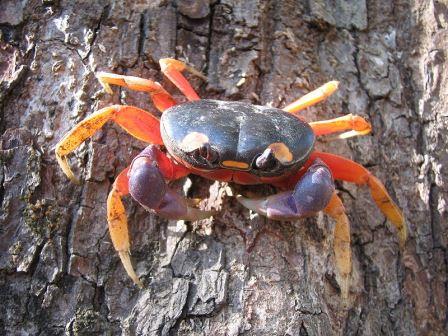
Halloween crab, Gecarcinus quadratus, at Nosara, Costa Rica. Photo credit: Wikimedia Commons.
Spookfish
The Spookfish, Macropinna microstoma, is also called the barreleye and is easily identifiable by its translucent head. The barreleye is a deep-sea fish found in tropical and temperate waters of the Atlantic, Pacific and Indian Oceans. Several fish are called ‘barreleyes’ because their eyes are tubular in shape. They live in almost complete darkness and have developed ultra-sensitive tubular eyes that can rotate inside their transparent heads. The eyes point upwards when searching for prey overhead and forward when the fish is feeding. The fact that the fish’s eyes can rotate was only discovered a few years ago by researchers at the Monterey Bay Aquarium Research Institute. Check out this video to see it swimming!
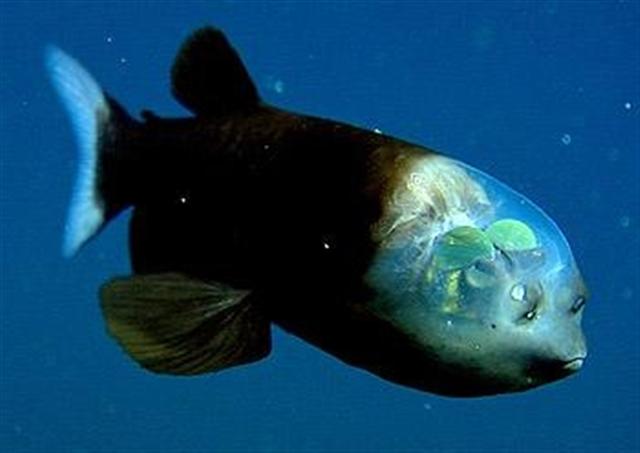
Spookfish, Macropinna microstoma. Photo credit: Monterey Bay Aquarium Research Institute.
Zombie worms
Thankfully, they’re not after your brain. Instead, these little worms crave bones. Osedax (Latin for ‘bone devourer’) worms grow only one to three inches (2-7cm) and have been found as deep as 10,000 feet (3,000m) below the surface, feasting on the bones of a rotting gray whale. To date, seven species of Osedax worms have been confirmed by the World Register of Marine Species.
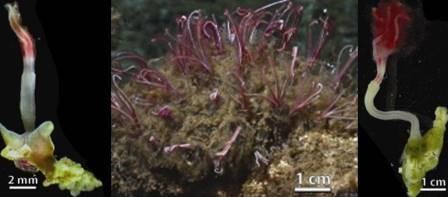
Zombie worms. Left to right: Osedax roseus, O. frankpressi and O. rubiplumus. Photo credit: Robert C. Vrijenhoek, Shannon B. Johnson & Greg W. Rouse.
Happy Halloween!
Emily Tripp is the publisher and editor of MarineScienceToday.com, an online magazine about what's in, on, and around the oceans. She holds marine science and biology degrees from the University of Miami's Rosenstiel School of Marine and Atmospheric Science.
